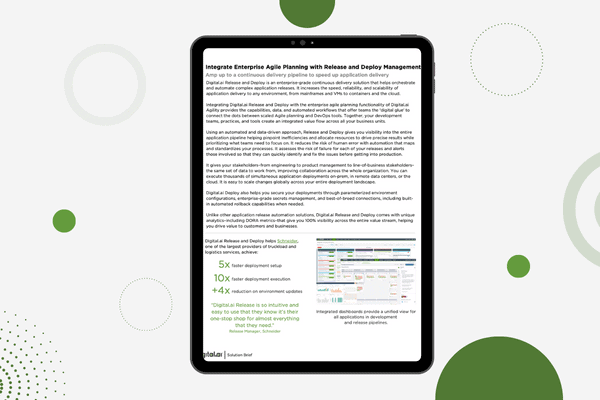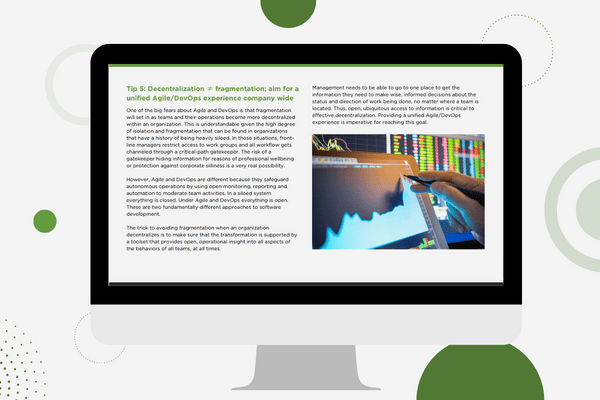Agile vs DevOps: Key Differences and How they Work Together
Discover the relationship between Agile and DevOps, understanding the methodologies and how they collaborate effectively for efficient software development.
Table of Contents
What is Agile DevOps?
Agile DevOps represents the fusion of Agile methodologies and DevOps practices, designed to enhance collaboration between development and operations teams, streamline workflows, and accelerate software delivery. By integrating continuous feedback, automation, and iterative development, Agile DevOps aims to improve both the speed and quality of software releases. This approach not only bridges the gap between development and IT operations but also fosters a culture of continuous improvement and innovation.
The Evolution of Agile DevOps
Overview of Agile Methodology
Agile methodologies originated in the early 2000s as a reaction to the rigid, slow-moving waterfall model of software development. The Agile Manifesto outlined values and principles focused on flexibility, collaboration, and customer satisfaction through iterative development and continuous feedback.
Overview of DevOps
DevOps emerged a few years later, around 2007-2008, as a set of practices and cultural philosophies to bridge the gap between software development (Dev) and IT operations (Ops). It’s meant to address issues such as slow deployment processes, lack of collaboration between development and operations teams, and the difficulty of maintaining stable production environments while also rapidly developing new features.
Understanding Agile and DevOps
Agile focuses on iterative development and continuous feedback to adapt quickly to changes and deliver customer-centric solutions. DevOps, on the other hand, automates and integrates the processes between software development and IT operations to ensure faster and more reliable releases.
Key Differences
Agile and DevOps, while both aimed at improving software development and delivery processes, differ in their focus, practices, and objectives. Let’s take a look at the differences, along with examples:
Focus and Objectives
Agile: The goal is to ensure that the development process is flexible and able to adapt to changing requirements.
Example: In Agile, work might be broken down into multiple sprints (usually 1-4 weeks each), where each sprint delivers a viable product increment. Teams gather feedback from stakeholders after each sprint to refine future work.
DevOps: Its primary objective is to shorten the system development lifecycle while delivering features, fixes, and updates frequently and reliably.
Example: A DevOps team might implement Continuous Integration/Continuous Deployment (CI/CD) pipelines to automate the testing and deployment of applications. This ensures that code changes are automatically tested and deployed to production as soon as they are committed.
Practices and Tools
Agile: Utilizes frameworks such as Scrum, Kanban, or Extreme Programming (XP) to manage work. Practices include daily stand-ups, sprint planning, and retrospectives.
Example: In a Scrum framework, a team holds daily stand-up meetings to discuss progress, plan a sprint backlog at the beginning of each sprint, and conduct retrospectives at the end to discuss what went well and what could be improved.
DevOps: Leverages tools and practices that support automation, continuous delivery, and infrastructure as code (IaC). Common tools include Jenkins, Docker, Kubernetes, and Ansible.
Example: A DevOps pipeline might use Jenkins for continuous integration, Docker for containerization, and Kubernetes for orchestrating containers across multiple environments.
Team Structure and Collaboration
Agile: Focuses on small, cross-functional teams that work collaboratively to complete tasks within a sprint.
Example: An Agile team consists of developers, testers, and product owners who work closely together to deliver user stories in each sprint.
DevOps: Emphasizes collaboration between traditionally siloed teams of developers and IT operations.
Example: In a DevOps environment, developers and operations engineers might work together to write scripts that automate the deployment process, ensuring smooth and rapid deployments.
Feedback and Improvement
Agile: Incorporates continuous feedback from customers and stakeholders to refine and improve the product incrementally, focusing on meeting customer needs and adapting to changes.
Example: After each sprint, Agile teams might review feedback from stakeholders to adjust priorities and make necessary changes in the next sprint.
DevOps: Focuses on continuous monitoring and feedback on the performance and reliability of software in production to detect issues early and continuously improve the system’s stability and performance.
Example: A DevOps team might use monitoring tools like Prometheus and Grafana to collect and analyze data from production environments, allowing them to proactively address performance issues.
Cultural Differences
Agile: Promotes a culture of flexibility, collaboration, and continuous improvement within the development team. It encourages frequent interactions and adaptive planning.
DevOps: Encourages a culture of shared responsibility, transparency, and collaboration between development and operations to promote a unified approach to software delivery.
How They Work Together
Agile and DevOps work together to enhance software development and delivery processes by leveraging their complementary strengths.
The integration of Agile and DevOps came about as organizations realized that combining the iterative, customer-focused approach of Agile with the automation and collaborative practices of DevOps could significantly enhance software development and delivery by streamlining workflows, improving communication between teams, and speeding up release cycle without sacrificing quality.
Key Principles of Agile DevOps
The key principles of Agile DevOps represent the core beliefs and guidelines that shape how teams implement and practice the methodology. These principles ensure that the components are used effectively to achieve the desired outcomes.
- Collaboration and Communication
- Promoting a culture of open communication and collaboration between development, operations, and other stakeholders.
- Example: Holding regular stand-ups and retrospectives with all team members to discuss progress and challenges.
- Continuous Improvement
- Emphasizing the need for constant feedback and iterative improvement in both processes and products.
- Example: Conducting regular retrospectives to identify areas for improvement and implement changes
- Automation
- Automating as many processes as possible to reduce manual effort, minimize errors, and speed up delivery.
- Example: Implementing CI/CD pipelines to automate testing and deployment.
- Customer Focus
- Prioritizing customer satisfaction by delivering valuable software continuously and incorporating customer feedback.
- Example: Using Agile practices like user stories and customer reviews to ensure the product meets user needs.
- Resilience and Reliability
- Ensuring that systems are resilient and reliable by integrating continuous monitoring and quick response to issues.
- Example: Using robust monitoring and alerting systems to detect and resolve issues promptly.
- Transparency
- Maintaining transparency in processes and progress to foster trust and collaboration within the team and with stakeholders.
- Example: Using dashboards and regular updates to keep everyone informed about the status of a project.
Agile DevOps in Practice
Agile DevOps Processes
Agile DevOps processes combine the iterative, incremental approach of Agile methodologies with the collaborative, automated, and continuous delivery principles of DevOps, streamlining workflows, reducing bottlenecks, and ensuring faster, more reliable software delivery.
- Sprint Planning and Execution
- Agile teams plan their work in short, time-boxed iterations called sprints. During sprint planning, the team defines the tasks and goals for the upcoming sprint, ensuring alignment with overall project objectives.
- DevOps practices support this by automating the setup of development and testing environments, ensuring the infrastructure is ready for each sprint’s workload.
- Continuous Integration and Continuous Delivery (CI/CD)
- Continuous Integration (CI): Continuous Integration (CI): Developers frequently merge their code changes into a shared repository. Automated build and test processes run to catch integration issues early.
- Continuous Delivery (CD): After passing automated tests, the code is automatically deployed to staging or production environments. This ensures that new features and fixes are delivered quickly and reliably.
- Example: A software development team uses Jenkins for CI to automate the building and testing of new code changes. Successful builds are then automatically deployed to a staging environment using tools like Docker and Kubernetes.
- Automated Testing
- Automated testing is integrated into the CI/CD pipeline to ensure that code changes do not introduce new bugs. This includes unit tests, integration tests, and end-to-end tests.
- Example: A team working on a web application uses Selenium for automated end-to-end testing. Each time new code is pushed to the repository, Selenium tests are run to ensure that all user interactions work as expected.
- Infrastructure as Code (IaC)
- IaC allows teams to manage and provision infrastructure through code, enabling consistent and repeatable deployments. Tools like Terraform, Ansible, and AWS CloudFormation are commonly used.
- Example: A financial services company uses Terraform to define and manage their cloud infrastructure, ensuring that environments are consistent and can be easily replicated for development, testing, and production.
Building an Agile DevOps Culture
Creating an Agile DevOps culture involves fostering an environment of continuous learning, collaboration, and improvement, where all team members are aligned towards common goals.
- Collaboration and Communication
- Agile DevOps promotes open communication and collaboration between development, operations, and QA teams. Regular meetings such as daily stand-ups, sprint reviews, and retrospectives facilitate this interaction.
- Continuous Feedback and Improvement
- Agile DevOps relies on continuous feedback from multiple sources, including users, automated tests, and monitoring tools. This feedback is used to make iterative improvements to the software and processes.
- Shared Responsibility
- In an Agile DevOps culture, all team members share responsibility for the quality and stability of the software. This means that developers, operations engineers, and QA professionals work together to ensure successful releases.
- Automation and Tooling
- Automation is a cornerstone of Agile DevOps, reducing manual effort and minimizing errors. Automated build, test, and deployment pipelines, as well as infrastructure management, are key practices.
Benefits of Agile DevOps
By integrating Agile’s flexibility with DevOps’ automation and collaborative practices, organizations can achieve a more efficient and responsive software development lifecycle.
Faster Delivery Time
Agile DevOps significantly accelerates delivery times by combining iterative development with automated integration and deployment practices. CI/CD pipelines ensure that code changes are rapidly tested, integrated, and deployed, minimizing delays caused by manual processes. This automation allows for quicker identification and resolution of issues, enabling teams to deliver new features and updates to users more frequently.
Increased Operational Efficiency
By automating repetitive tasks such as code integration, testing, and deployment, organizations reduce the manual effort and errors associated with these processes, leading to more efficient operations.
Improved Quality Assurance
The integration of continuous testing and feedback mechanisms within Agile DevOps ensures a higher standard of software quality. Automated testing embedded in the CI/CD pipeline allows for continuous validation of code changes, enabling early detection and resolution of issues, significantly reducing the likelihood of bugs and enhancing the overall stability and reliability of the software. Additionally, the incorporation of continuous feedback from monitoring tools and user inputs helps teams to iteratively improve the software, addressing performance issues promptly and aligning the product more closely with user needs.
Challenges in Agile DevOps Implementation
Technological Challenges
Agile DevOps implementation faces challenges in integrating various tools and technologies, dealing with complex and disparate systems, and overcoming technical debt and legacy system issues.
People and Culture Challenges
Successfully implementing Agile DevOps poses significant cultural challenges, including breaking down silos between development and operations, fostering collaboration and shared responsibility, and promoting open communication and trust. This transition requires overcoming resistance to change and a commitment to continuous learning and adaptation. Leaders must champion these cultural changes to build a cohesive team capable of implementing Agile DevOps practices effectively.
Process Challenges
Process challenges in Agile DevOps implementation arise from the need to align and integrate different methodologies and workflows. Aligning these processes requires rethinking traditional workflows to support a more fluid and integrated approach. One common process challenge is managing the balance between speed and quality. Agile DevOps aims to deliver software quickly, but this must be done without compromising the quality and reliability of the product. This requires implementing robust testing and monitoring processes that can keep up with the rapid pace of development. Additionally, ensuring consistent and efficient processes across multiple teams and projects can be difficult, especially in larger organizations. Standardizing practices while allowing for flexibility to adapt to specific team needs is crucial. Effective process management involves continuous evaluation and improvement, leveraging feedback and data to refine and optimize workflows.
Best Practices in Agile DevOps
Implementing Agile DevOps effectively requires following several best practices to ensure seamless integration, collaboration, and continuous improvement. Here are some practices and how Digital.ai helps enterprises adopt them:
Adopting a Learning Culture
A learning culture is essential in Agile DevOps, promoting continuous improvement and innovation. Teams must be encouraged to experiment, learn from failures, and continuously update their skills and knowledge. This involves providing opportunities for training, workshops, and keeping up on the latest industry trends and tools..
Emphasizing Collaboration Across Teams
Digital.ai facilitates collaboration through integrated tools that support collaboration and communication. These tools help teams coordinate their efforts, share information in real-time, and maintain alignment with business objectives.
Automating Wherever Possible
Automation is a cornerstone of Agile DevOps, reducing manual effort, minimizing errors, and speeding up the development and deployment processes. By automating repetitive tasks such as code integration, testing, and deployment, teams can focus on more strategic activities. Digital.ai offers a range of automation tools that streamline these processes. Our solutions include CI/CD pipelines, automated testing frameworks, and infrastructure as code (IaC) capabilities. These tools ensure that code is continuously integrated, tested, and deployed with minimal manual intervention, enhancing efficiency and reliability across the software delivery lifecycle.
By leveraging the Digital.ai AI-powered DevSecOps platform, enterprises can effectively implement Agile DevOps best practices, leading to faster delivery times, increased operational efficiency, and improved software quality. For more detailed insights, visit the Digital.ai Agile Software Development Success Guide and the Digital.ai Integrate Agile and DevOps Solution Brief.
Trends in Agile DevOps
Agile DevOps continues to evolve, driven by advancements in technology and changes in business needs. Several key trends are shaping the future of Agile DevOps, and Digital.ai is at the forefront, providing tools and support to help enterprises leverage these trends effectively.
1. AI and Machine Learning Integration
One of the significant trends in Agile DevOps is the integration of Artificial Intelligence (AI) and Machine Learning (ML) to enhance automation, predictability, and decision-making. AI and ML can be used to predict potential issues in the development pipeline, optimize resource allocation, and automate routine tasks.
Digital.ai leverages AI-powered insights across the software development lifecycle. Their platform uses AI to provide predictive analytics, identify bottlenecks, and suggest improvements. This helps teams make data-driven decisions and proactively address issues before they impact the production environment.
2. Security Integration (DevSecOps)
Security is becoming increasingly critical in the software development process, leading to the rise of DevSecOps, which integrates security practices into the DevOps pipeline. This trend ensures that security is addressed throughout the development lifecycle rather than being an afterthought.
Digital.ai provides tools that integrate security testing into the CI/CD pipeline, ensuring that vulnerabilities are identified and addressed early in the development process. Our solutions help enforce security policies and compliance requirements automatically, reducing the risk of security breaches and ensuring that software releases are secure and compliant.
3. Enhanced Collaboration and Remote Work
The shift towards remote work has highlighted the need for enhanced collaboration tools and practices. Agile DevOps teams are increasingly using cloud-based platforms that support remote collaboration, real-time communication, and shared access to resources.
Digital.ai offers a suite of tools that facilitate collaboration across distributed teams. Our solutions provide real-time visibility into the development process, allowing team members to collaborate effectively regardless of their physical location. Features such as integrated portfolio management, automated workflows, and communication tools help teams stay connected and productive.
4. Microservices and Containerization
The adoption of microservices architecture and containerization is another significant trend in Agile DevOps. These technologies enable teams to develop, deploy, and scale applications more efficiently, providing greater flexibility and resilience.
Digital.ai supports microservices and containerization through their comprehensive DevOps toolchain. Their platform integrates with container orchestration tools like Kubernetes and Docker, allowing teams to manage and deploy microservices effectively. This integration ensures that applications are scalable, maintainable, and can be deployed rapidly and reliably.
5. Continuous Everything
The concept of continuous everything—continuous integration, continuous delivery, continuous testing, and continuous monitoring—is becoming a cornerstone of Agile DevOps practices. This approach ensures that every aspect of the development and deployment process is automated and optimized for speed and reliability.
Digital.ai’s platform is designed to support continuous integration, delivery, testing, and monitoring. By automating these processes, Digital.ai helps teams achieve faster release cycles, higher quality software, and more efficient operations. Our tools provide end-to-end visibility and control over the entire development lifecycle, ensuring that continuous practices are effectively implemented and maintained.
Conclusion
Agile DevOps is evolving to incorporate new technologies and practices that enhance efficiency, security, and collaboration. Digital.ai is at the forefront of these trends, offering a comprehensive suite of tools and solutions that support AI integration, DevSecOps, enhanced collaboration, microservices, containerization, and continuous everything. By leveraging Digital.ai’s platform, enterprises can stay ahead of the curve and achieve their digital transformation goals.




